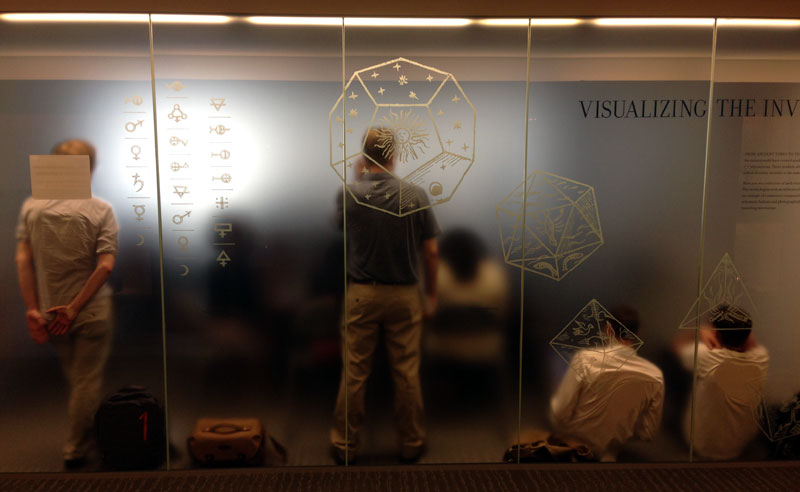How to plan a great SRCCON session
by Ryan Pitts

Standing-room only during a session at SRCCON 2014. (OpenNews Photo)
So you want to run a session at SRCCON? High-five, it’s going to be great! You’ll be in a room full of other smart developers, designers, and journalists, all of whom are going to help you make the most of your time together.
SRCCON is a little different than most journalism conferences; you won’t need to prep a 45-minute slide deck, and you won’t need to put together a panel of subject experts to deliver wisdom to a crowd. You’ll be part of a highly participatory event, where attendees are ready for conversation and participation. It’s an engaged audience that lets you explore topics you might not tackle in other venues—you don’t have to be confident that you have a solution to explain, you just need to be confident there’s a problem worth working through.
That doesn’t mean you want to show up unprepared, though. You’ll sketch and develop and outline differently, but running a great hour (or three) at SRCCON still requires a plan. Here are a few things that can help you lead a session that sends everyone away with new ideas, yourself included.
Getting focused
- Have an outcome in mind. Start out your session plan by thinking about the end. Will you be walking people through a new piece of tech? Are you leading a discussion in search of a list of best practices? Do you want to build documentation together? Spend a sentence in your session description telling people what they’ll leave with, and you’ll have an easier time focusing on how to get there.
- Find the right scope. Feature creep in projects is bad. So is feature creep in a conference session. Journalism has plenty of big ideas and big problems to talk about, but if you want get anywhere in an hour or so, it’s smart to pick out a smaller slice to work through. It’s OK to (gently) correct course if discussion starts veering off, but use your judgment. Sometimes those tangents can be interesting.
- Come up with a budget for your time. Outlines seem a little less daunting once you break them into smaller pieces, and knowing how you want to spend your time helps you stay on task while you’re doing it live. A basic SRCCON session timeline might look something like: 5 minutes of setting the stage for your topic, 10 minutes of walking through a detailed example, 25 minutes of small-group discussion, and 20 minutes of leading groups through reports back to the whole room. If you’re teaching a new skill or running a hack session, of course, you’ll want more time for work, and if you’re leading a conversation, you’ll want more time for talk. But sketching out an intended timeline helps you move toward the outcome you want to deliver.
Your toolkit
- Be strategic with your slides. No, SRCCON sessions don’t have big slide decks. But yes, you can absolutely deploy slides if they’re going to help! Showing a few examples can be just the thing to provide context for a conversation, and putting discussion questions up on the big screen for small groups to refer to, that’s just plain kind.
- Take advantage of the other tools at hand. Whiteboards, giant scratch pads, post-it notes … we’ll make sure you have all the supplies you need to capture people’s thoughts. If you want to send people away with ideas they can act on, grabbing a marker and whiteboarding the best comments from the room is leading by example.
- Use a shared document for live notes. Firing up a collaborative document as your session begins helps people build on each other’s work, gives you a place to drop clickable URLs, and creates a resource that everyone can come back to later. There are plenty of options here, but we’ve seen etherpads work particularly well at SRCCON.
Providing guidance
- Yes, and. You’ll be giving shape to the discussion that emerges during your session, so it falls to you to give it tone as well. It’s a conversation, not a debate. Try to make sure the room isn’t dominated by just a few voices; keep an eye out for body language that says “I might have something to add” even when that person doesn’t feel confident enough to cut in. And when you do get a comment that’s not quite right, you can almost always find part of it to build on.
- You don’t have to go alone. It can be hard to lead a group of inquisitive people toward a common goal, all while keeping track of timelines, information you want to impart, and ideas from your audience. Co-facilitators are one great way to lighten the load, especially if you work out a back-and-forth that keeps each of you from having to be “on” the whole time. But also, don’t be afraid to ask an enthusiastic attendee to help you whiteboard or keep an eye out for people with something to say.
- Fun is good. Ultimately you want your session to wrap with everyone learning something new, and making an abstract concept real to people can be a trick. Trading horror stories about the times things went terribly wrong are a classic way to illustrate why you think a topic is important, and to remind the room that hey, we’re in this together. And they often happen to be pretty entertaining. Or pull out the game box, and pass out pirate coins for an exercise in newsroom budgeting, or play werewolf to kill features for an imaginary product.
Plan to set your plan aside
- Think through what happens with 5 people, 15 people, 50 people. Odds are, sessions will be pretty evenly attended, and you’ll have an average-size crowd in your room. But sometimes you end up schedule opposite a scorching hot topic—and sometimes you are the hot topic. Take some time to imagine how you might accommodate (a lot) more or (a lot) fewer people than you’re expecting. You’ll be much happier than if you end up having to adjust without a plan.
- Consider points of entry for non-experts. Every single person at SRCCON is brilliant and creative. But not every person in your room will be an expert in the subject you’re covering. One of the best ways to attend a conference like this, in fact, is to go to sessions that challenge you, about topics you wouldn’t normally choose. So how will you involve a designer in your engineering session? Bring a filmmaker’s thoughts into a conversation about writing? Just as these people are there to be exposed to new ideas, your topic can benefit from an outside perspective.
- Outline like you’re writing a choose-your-own-adventure. It’s easy to imagine your session’s best-case scenario: You introduce the topic and people “oooh.” You show an example and they “ahhhh.” Small groups write code or trade personal anecdotes in a flurry of post-it notes, and the perfect list of best practices emerges from conversation at the end. But what if you ask your first question and hear crickets? What if your audience mostly showed up to learn, and doesn’t have enough collective experience to share? What if someone drops an amazing idea on the room, and you want to spend more time on it than you’d scheduled? You’ll be responding to situations like these on the fly, and you’ll be a lot more confident if you’ve mapped out some strategies in advance. Plan more material than you’ll need, and know you can feel good about dropping half of it—you just don’t know which half it will be.
SRCCON sessions work best when your audience is as engaged as you are, and walking in with a plan can make that happen. We hope these guidelines get you thinking, and if you have your own thoughts to share, let us know! We’ll keep updating this document with more questions and ideas.
The latest from the OpenNews team
OpenNews receives Press Forward funding to develop emergency preparedness infrastructure for news
Read all our news in our OpenNews blog

